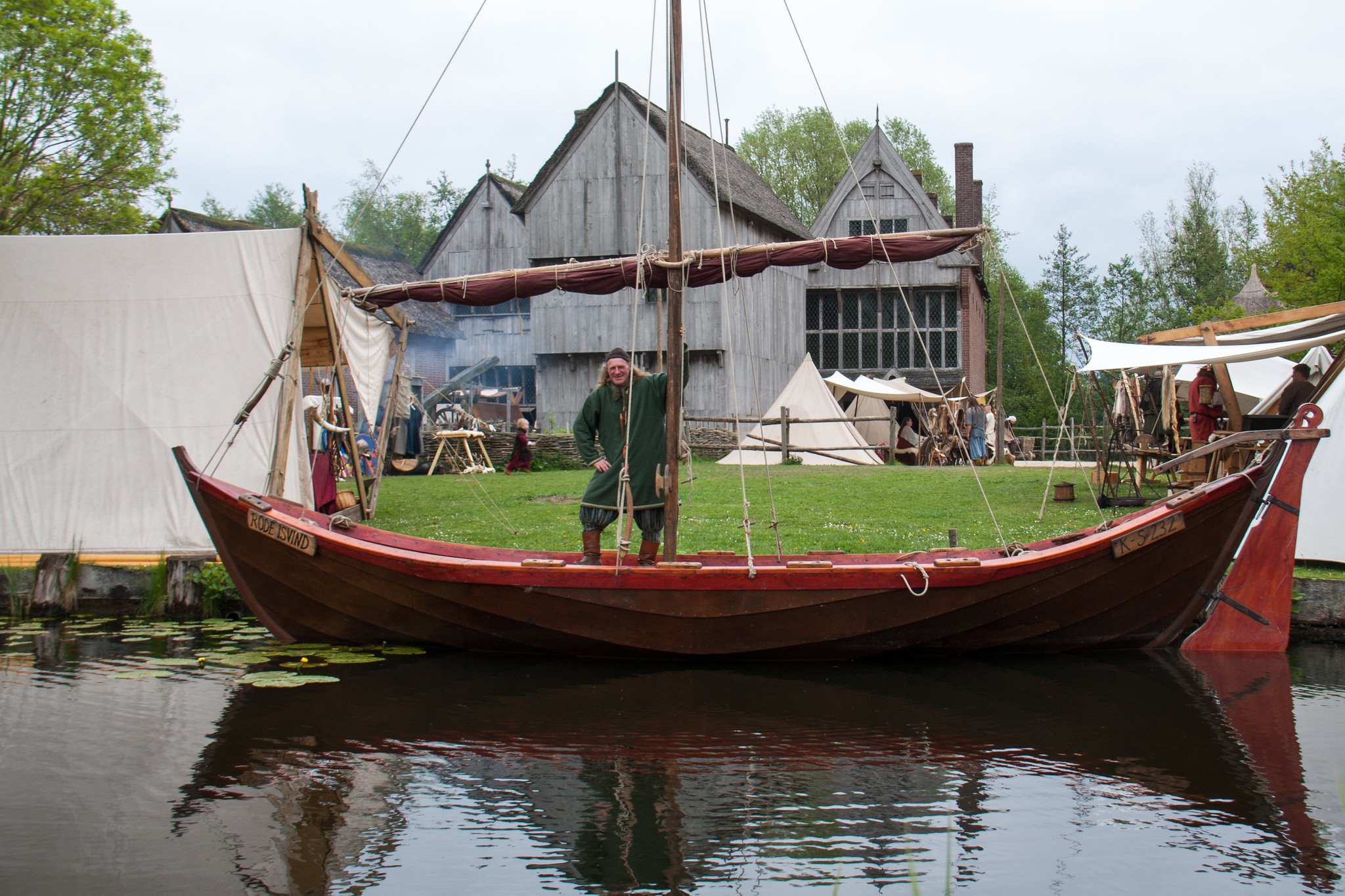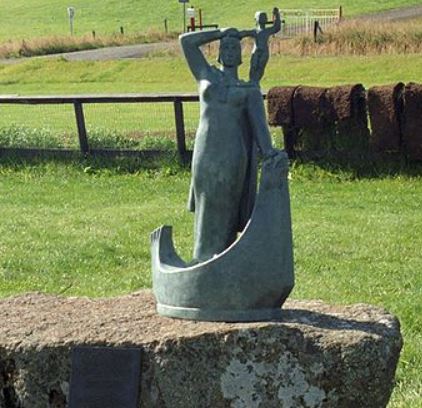While Christopher Columbus was once widely credited with “discovering” the already populated America, Viking expeditions to the New World took place centuries before Spaniards set foot on the lush tropical islands of the Caribbean – and in a time before frigate-sized sailing ships became the norm for maritime exploration and dominance.
One of the most prominent stories features one Leif Erikson – or as he is more commonly known, “Erik the Red” – the Viking explorer who sailed to what his people called Vinland – the “wine land.” The stories shared of his escapades chronicle a time before America stepped onto the global stage.
Alongside Erik the Red, a lesser known individual made her mark as one of few female explorers to sail the Atlantic. Her tales of leadership in times of strife have been inscribed in Viking folklore and myths to this very day.
The different tales of Gudrid
Gudrid Thorbjarnardottir was a Viking woman who sailed with her husband and a small crew to Vinland (present-day Canada), which was named for its evergreen peninsulas. Living in and exploring Newfoundland and beyond, she made eight crossings over the Atlantic and travelled farther than any other Viking, reaching as far as Rome.
The story of Gudrid is told in two separate Vinland sagas; The Saga of the Greenlanders and The Saga of Erik the Red, where the accounts differ somewhat.
Success
You are now signed up for our newsletter
Success
Check your email to complete sign up
In The Saga of the Greenlanders, Gudrid was a poor woman with a “striking appearance, and wise,” who found herself washed up at shore as she travelled to Greenland. In The Saga of Erik the Red, she was a rich person who braved the Greenland winters on her way to Vinland.
Regardless of the discrepancies, there is much that is solid and consistent to the tales.
Gudrid was born on the peninsula of Snæfellsnes in Iceland around the late tenth century before she traveled with her father, Thorbjorn, to Greenland at age 15. The two were accompanied by Eirik, a troublemaker who was in the works of forming a new Viking settlement. Gudrid was married to Eirik’s younger son, Thorstein, brother of Erik the Red.
According to The Saga of the Greenlanders, Thorstein made his voyage toward the New World, and Gudrid is believed to have followed along. In both tales, the couple failed to make it to Vinland, and were forced to shift to Greenland before the winter.

The Saga of the Greenlanders holds that Gudrid and her husband were shipwrecked in Greenland before they were rescued by Erik the Red’s son, Leif the Lucky. Faced with blistering winds of the freezing winter, those who accompanied Gudrid, including her husband, began to die from sickness. Despite the deaths, Gudried carried on with her travels.
According to The Saga of Erik the Red, Gudrid did not have her husband with her when she travelled to Greenland, nor did she get shipwrecked. When she arrived, the island was faced with a famine. To spare the lives of the settlers, Gudrid took part in a pagan ritual with a seeress named Thorbjorg, even though she was a Christian.
The seeress told her, “from you will be descended a long and worthy line, and over all the branches of that family a bright ray will shine.”
After Thorstein died of a plague, his ghost stayed with Gudrid to tell her “that her destiny [would] be a great one,” prompting her to return to the Greenland settlement. There, at 17 years old, Gudrid married an Icelandic merchant named Thorfinn Karlsefni, whose name means “the makings of a man.”
With Thorfinn by her side, Gudrid made her journey to the New World, where she gave birth to a son named Snorri; who, if the tale is true, would be the first European baby born on the North American continent.
Three years later, the family returned home. While one saga tells of a quick stop in Norway, both sagas tell of Gudrid’s return to Iceland, at a farm called Glaumbær (now a protected site owned by the National Museum of Iceland).
The Saga of the Greenlanders relates the chronicles of Gudrid’s life after her harrowing Greenland chapters. In her 40s or 50s, she made a pilgrimage to Rome almost entirely on foot. She then returned to Glaumbær as a “nun and recluse,” though scholars are unsure what a Viking nun in the 11th century looked like.

Gudrid’s story is cemented as a legend in both sagas. The Saga of the Greenlanders paints her as knowing “well how to carry herself among strangers.” This appears to be proven in Gudrid’s interaction with an indigenous North American woman. From there, she became a matriarch for other Icelanders to follow in her footsteps.
The Saga of Erik the Red describes her as the “fairest of women,” with a melodious singing voice. Her role in the saga has been so vital that it has also been known to be called Gudrid’s Saga.
At her birth home of Laugarbrekka in western Iceland, one can find a sculpture of the celebrated explorer in which Gudrid stands over a dragon’s head that forms the bow of her small boat, carrying Snorri on her shoulder as she eyes the seas before her.
The truth?
As with countless ancient texts and tales, these stories tend to become blurred over time, leaving the particulars to be questioned by historians. Medieval tales would include supernatural elements like ghosts, dragons, witches and other mythical forces, and Gudrid’s sagas were no exception.
However, the sagas do include references to documented events and figures, such as the names of kings and queens, real battles, settlements and cities. “[The sagas] all claim to present some kind of truth,” wrote scholar Lans Lonnorth.
Nancy Marie Brown, author of a 2007 biography about Gudrid titled The Far Traveler: Voyages of a Viking Woman, believes that seeking the plausibility of the tale instead of the whole truth is a “far better barometer for testing the stories’ veracity.”
Both sagas of Gudrid were passed down orally for two centuries before they were finally chronicled in the 13th century. Had the written tales become too far-fetched, those familiar with the characters portrayed would likely have said something against them.
Moreover, Brown and other scholars believe that some parts of the stories are based on actual events, despite the presence of supernatural elements. Archaeologists have also claimed to have unearthed Gudrid’s final Glaumbær house in Iceland, offering hope that archaeology could help in verifying the stories.
L’Anse aux Meadows, located in Newfoundland, is the only known Viking settlement in North America, having served as the staging grounds of exploration southwards. Carbon dating has put the foundation of the settlement at around 1000 A.D., around the same time as Erik the Red and Gudrid’s times in the New World.
Genealogy also sees the passing of the story to other authors and descendants of Gudrid.
Even with new findings from different fields of research, there are still more questions than answers; yet there is little doubt about the influence Gudrid had and perseverance she displayed in her arduous adventures in exploration.













